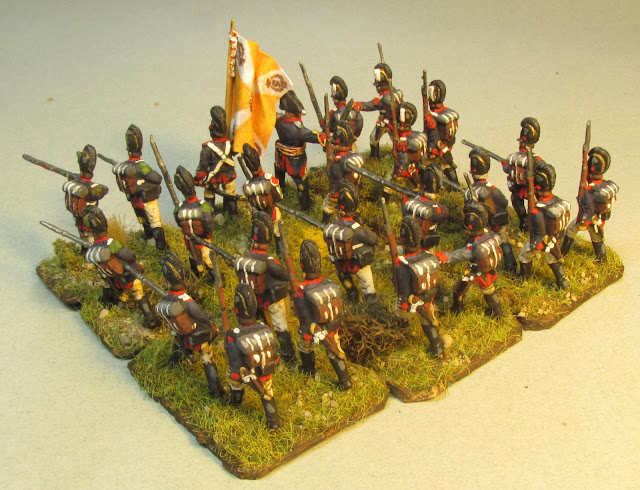
For a long time now I have had the intention of painting up this regiment for our future Talavera campaign and earlier this summer finally got around to doing that. A while ago I had purchased the HaT Bavarian Fusiliers set and the HaT Württemberg Artillery set as likely figures to complete this project. With a few very small changes they worked quite well as Baden troops, allowing me to paint up the 1st and 2nd Battalions along with their supporting artillery.
 |
| Not too much in the way of adaptations for these. The command figure is from the HaT Saxony set, with added plume, epaulettes and sash and the flag bearer was adapted from the Württemberg artillery set. Plumes and epaulettes were added to some of the fusilier figures for the flank companies. |
A Bit of History
 |
| Musketeer, Grenadier and Grenadier Officer of the 1st Battalion, Spain 1809, by H. Boisselier |
The Grand Duchy of Baden was one of the original sixteen small German states that formed the “Confederation of the Rhine” on July 12, 1806. Under the “protection” of Napoleon, this was mostly a military alliance, obliged to supply and maintain substantial armies in support of Napoleon’s France. Eventually the Confederation was to grow to include thirty-six member states, but in the long term these states found themselves even more obliged financially, politically and militarily to Napoleon than they had been under their previous masters, the Hapsburgs.
The Grand Duchy of Baden was required to contribute 8000 men to the Confederation of the Rhine forces. After the 1812 defeat in Russia the Baden regiments serving in Napoleon’s Grand Armée were virtually eliminated and the Grand Duchy, along with most of the other states of the Confederacy, soon threw their lot in with the Allies.
In Spain
In 1808 the regiments had been re-organized along French lines, i.e. four centre companies, musketeers; and two elite companies, a grenadier company and a schützen company. At that time the 1st Battalion of the 4th Infantry Regiment and the 2nd Battalion of the 3rd Infantry Regiment were combined to form a new regiment for service in Spain, the Linien-Infanterie-Regiment Nr 4. This regiment formed part of IV Corps 2nd Division under General Leval at Talavera and continued to serve in Spain until July 1813 when the 1st Battalion was sent home. The 2nd Battalion and artillery contingent stayed to serve with General Vilatte’s Reserve Division until December 1813, when word reached Span of the collapse of the Confederation and the shift in Baden’s loyalties. The remaining Badeners were disarmed and sent home under guard as prisoners of war.
 |
Gunner, Spain 1809,
by H. Boisselier
|
Artillery
The 3rd Foot Battery that served in Spain would have had eight guns of Prussian origin, but by 1809 Gribeauval tubes had replaced the originals although still mounted on Prussian carriages. These guns were lost in the retreat from Vittoria - the gunners continued to serve until the end of 1813.
I took some liberties with the ordnance. It was painted as shown until 1806, ochre with black ironwork, after which it was painted dark grey. But I liked the ochre better!!
For further reading I would recommend the excellent ebook by William J. Rawkins, The Army of the Duchy of Warsaw: 1807 - 1814
And a few photos...
 |
| And here are some flag images that I downloaded from Warflag.com augmented with a bit of Photoshop work. Interestingly enough, the 1st Battalion above carries a 4th Regiment flag and the 2nd Battalion a 1st Regiment flag, which is correct (as I understand it) because both still carried the flags that they would have had prior to the 1808 re-organization. |
































Beautiful figures and I do like the terrain !
ReplyDeleteLove those figures. Looking forward to your Talavera game.
ReplyDeleteCheers, Monty. I'm looking forward to Talavera as well - just about there, figure-wise.
DeleteYou have done a great job on these figures, and the terrain is particularly impressive too!
ReplyDeleteThank you - I'm glad you liked them.
Delete